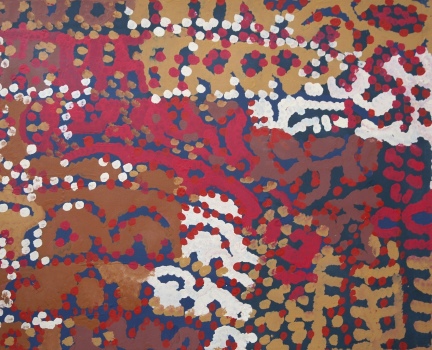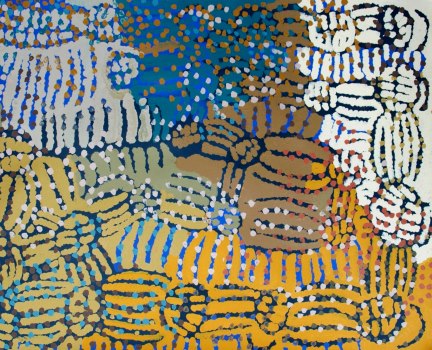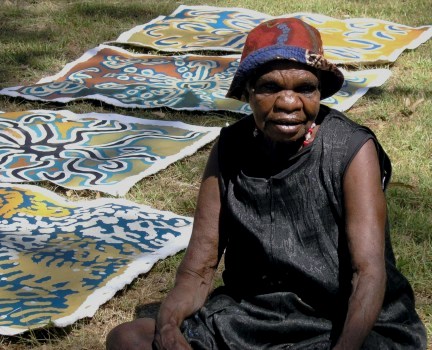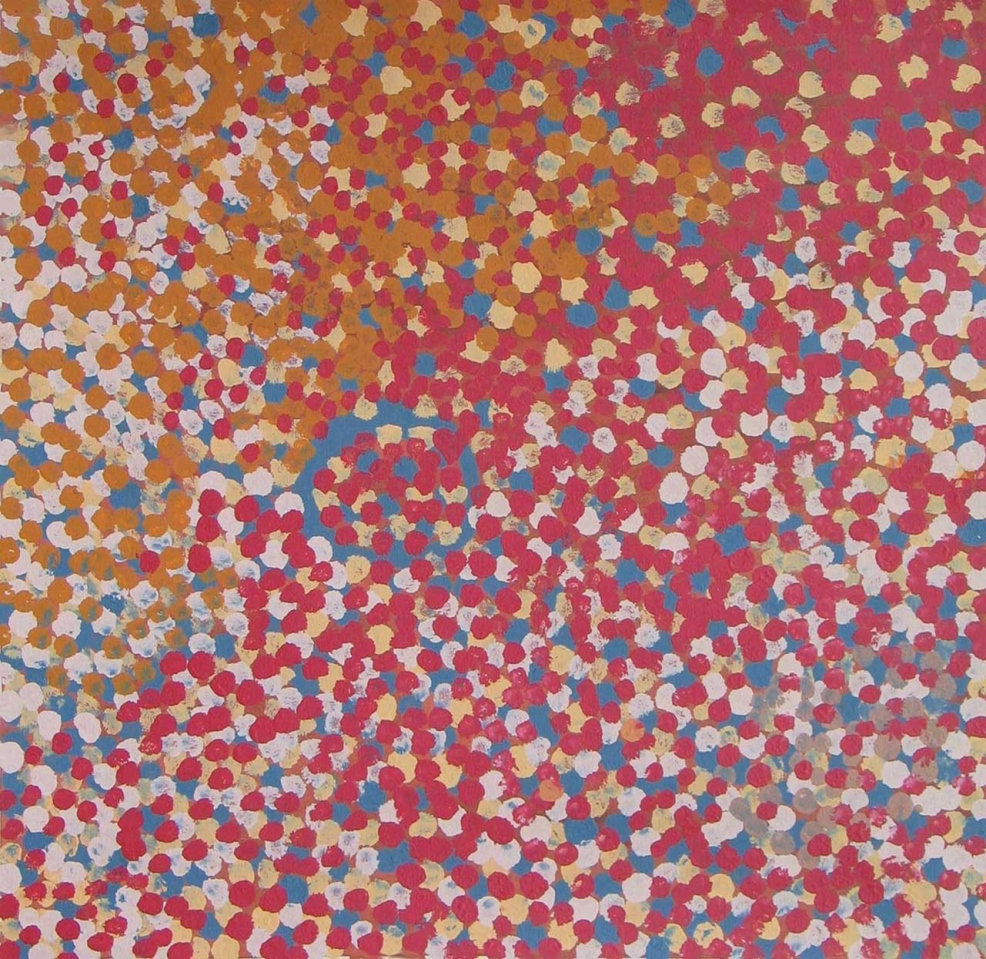The Art of Lorna Napurrula Fencer (c1925 – 2006)
First Meetings
Since first meeting Lorna Napurrula Fencer at Lajamanu community in 1999, I had a feeling that Lorna was an artist with a big story to tell and a unique way of telling it. Japingka Gallery held its first exhibition of Lajamanu artists from the Warnayaka Arts cooperative in August 1999, including work by Lorna, and assisted in a large exhibition of their works for the Sydney Olympics in 2000. Japingka Gallery held regular exhibitions of the artists from that time, and in 2002 I began the first of many artist’s workshops with Lorna, preparing works for solo exhibitions. In 2003 Lorna flew to Perth with her daughter Judy, staying for three weeks while working on new paintings.
Lorna's Early Work
From the beginning it was apparent to me that Lorna was a non conformist amongst a very traditional group of Warlpiri painters. Other painters commented on her approach, and more than once I heard artists criticise Lorna for the way she combined colour and image. – “ That’s not the way we do it – the drawing has to be in black with white dots around it. You can’t use those other colours, we’ve always used black with white on the outside.”
Lorna would just stare back and shake her head, sometimes just loudly assert ‘No’. The issue was an important one because as a peer group dealing with traditional lore in painting, and with a number of significant elders in the group, each was using a set of shared traditional images that was well understood by all parties. Certain rights were being asserted and tested, and the concept of innovation within a tradition was being argued out on the studio floor.
Lorna continued to take the innovator’s role, and received some scorn and derision for doing that. It was non-threatening, perhaps competitive banter, but I think it reinforced Lorna's motivation and resolve. Later as she completed some large, strongly coloured canvases, Lorna took great pleasure in the impact of the work, the authority and the compelling force that they had over an audience. Perhaps that was her way of silencing her home critics.
When I first saw Lorna working at Lajamanu, it was evident that she approached painting in a different way to most of her contemporaries. Her closest contemporary was Lily Hargraves, who was equally free in the way she applied paint to the canvas.
Differences in Lorna's Approach
While most painters worked on a modest scale, 120 x 90 cm canvas was a relatively large size at Warnayaka at the time, Lorna wanted to push boundaries on scale, on colour, on the large size brushes she wanted to work with – all of which pushed the paintings to be more spontaneous and open.
Lorna had a very astute sense of colour. She could work in a very tight group of tonal colours, which is where she began with her painting, or she could use the most high intensity colours and combine them together. She often demanded some primary colour that was missing from the jars of paint that she had at her side.
My initial response to Lorna’s work was that she was pushing the boundaries of Lajamanu painting. It was in her personality and her style. She was assertive, keen to try out new approaches, very spontaneous. She liked to work quickly, didn’t like to go back over anything once it was done. Sometimes a painting didn’t work well, but Lorna was on to the next one. That allowed her to test out a lot of things quickly.
Motivations
Lorna was equally as committed to the traditional stories as her peers – she regularly articulated the same stories that belonged to her Napurrula skin group, painting the linear designs as the first stage of every painting. Most often she painted the Yarla - Bush Potato or Yam Dreaming, that was associated with Yurmurrpa and a Law place for which her late brother was custodian. Related to the Yarla story was the Warpurti paintings of the small Bush Potato, a story around the conflict that divided Ancestors in a battle over custodianship over Yarla and Warpurti Dreamings. Lorna also often painted the Caterpillar Dreaming that was associated with Yurmurrpa and was under custodianship of her late brother.
In retrospect I believe Lorna has painted some of the great Warlpiri paintings of the contemporary desert art movement.
Around the year 2000, the National Gallery of Victoria was developing its new site at Federation Square, and created a temporary exhibition space at the northern end of Melbourne’s CBD. When I first walked in there and saw Lorna's painting hanging alongside Helen Frankenthaler and other artists of the New York school, I was moved and impressed. Lorna’s work looked at ease in that company, had the right gravity and impact to hold its own, and was a logical extension of the concepts of those modern urban abstract works.
The Painter at Work
When Lorna was painting it was an adventure to be on. With the large works they could change dramatically as Lorna slid around the canvas, sometimes sitting on top of the canvas laid out on the ground. New colours were applied, sometimes over large stretches of the canvas, and the dynamics changed completely. A painting that looked to be heading in one direction was radically altered by the process as Lorna painted in the next colour.
When a work was finished, Lorna would wave her hand in a dismissive gesture, indicating to take the canvas away to dry. When I first saw her do this, I mistook her meaning, assuming that she didn’t want me to stand around while she finished off a painting, and wanted me to stand away. Then she got cranky because I wasn’t moving the still wet canvas away as she instructed. Lorna wasn’t dismissive of her canvases for long. After a while she would walk around the works, smiling and waving her hands if she liked the results.
Lorna was a spontaneous painter who worked quickly, but considered her next moves carefully. Sometimes I would see her with her hand hovering over the box that held the paint pots. She would glance at the colours and then back at the painting where she was working. Then she would dart in, grab one of the colours that suited her needs, and she would be away again with her brushes.
Painting was a joy for Lorna, she liked the process and she liked the recognition it brought her.
Later Career and Solo Exhibitions
The nine solo exhibitions by Lorna that Japingka Gallery organised between 2002 and 2008 were extraordinary visual events. Once an exhibiting space started to fill up with Lorna’s canvases, the air was electrically charged – there was colour and dynamics and energy. The canvases sang out from the walls. On the occasions that Lorna attended an opening, she would bounce from one canvas to another, sometimes crossing the room to point out a painting whose story carried on from the one she was just singing to or talking about.
The solo exhibitions demonstrated the great power that was inside the slight body of the artist. The best works were always powerful and demanding, energetic, alive. When the artist stood in front of a large canvas she looked small against it. That was until she started to sing or talk, and then all the power in the canvas was apparent from inside the artist.
Lorna Fencer and Japingka Gallery
Lorna was one of the leading artists that Japingka Gallery promoted from 2000. We arranged a representative agreement with Lorna and her family, and committed to promoting her nationally. By nature Lorna was a prolific artist and painted for a number of dealers and some galleries. Many discussions were had about maintaining quality standards and representation issues, but ultimately Lorna loved to paint and did so on most opportunities where she could.
While we worked with and represented her, Lorna held solo exhibitions at Japingka Gallery in Fremantle, Vivien Anderson Gallery in Melbourne, Hogarth Gallery, Gow Langsford Gallery and Mary Place in Sydney, and Tandanya in Adelaide. A number of other galleries included these works in group shows including Gallery Gondwana in Alice Springs and Sydney, and Framed Gallery in Darwin.
We worked closely with Lorna to ensure her representation was of a high standard and her work presented seriously. I made many field trips each year to visit Lorna and to ensure the readiness of a quality body of work for each exhibition.
Personal Life
Lorna was both a hard task master and a positive force in the life of her family and friends. She had family living in both Lajamanu and in Katherine, and there were constant visits between the two, and infinite needs of everyone involved to receive financial assistance. Lorna would pay all the extended members of her family at the end of a day’s work painting. There was jubilation and disgruntlement, but there was only one financial contributor, Lorna, and everyone was fed and clothed from her endowment. Lorna could bathe in the prestige, she was the matriarchal head of this household. She feigned resentment of all the humbug that followed her around, but secretly I believe she revelled in the role. Occasionally towns people jokingly called her the Queen of Katherine.
Lorna lived in tough conditions during those times, her family mostly living in the Warlpiri camp at Katherine. Sometimes they had one of the larger houses, sometimes they camped around a caravan that the artist had earned from her painting. When I first met with Lorna her family were living out of doors under a tree and a bark shelter. It was always difficult to secure your belongings, and so food and blankets regularly went missing.
One evening I returned with Lorna to the camp and a girl came rushing up to Lorna- “you’re camp’s all burnt and your mattress and your keycards and everything. Nothing left – all gone.” Lorna was distressed, cried, abused the young people who stayed behind for not protecting her things and the camp.
Later the next day Lorna laughed at herself for crying, for getting worked up over the issue. She laughed at what she saw as a kind of weakness, her crying, when everything around her was chaos and disruption. Lorna was a tough lady, generous and compassionate, basically giving everything to her extended family members.
………………………………………………………………………………………………………………………
Exhibitions
2008 Women’s Law, Japingka Gallery, Fremantle WA
2007 Lorna Napurrula Fencer - A Tribute, Japingka Gallery, Fremantle WA
2006 Luminaries of the Desert, Japingka Gallery, Fremantle WA
2005 Lorna Napurrula Fencer, Hogarth Galleries, Sydney NSW
2005 Divas of the Desert, Gallery Gondwana, Alice Springs NT
2005 Lorna Napurrula Fencer- Yumurrpa - Paintings 2005, Vivien Anderson Gallery, Melbourne VIC
2004 Divas of the Desert Gallery Gondwana, Alice Springs NT
2004 Big Country, Gallery Gondwana, Alice Springs NT
2004 Yumurlpa, Gow Langsford Gallery, Sydney NSW
2004 Telstra Awards – Finalist, Darwin NT
2003 Serenitiy - Past and Present, Walsrode
2003 Lorna Napurrula Fencer, Chapman Galleries, Canberra ACT
2003 Lorna Napurrula Fencer – Paintings 2003, Vivien Anderson Gallery, Melbourne VIC
2003 Lorna Napurrula Fencer –New Paintings, Japingka Gallery, Fremantle WA
2003 Big Country (Group Exhibition) - Gallery Gondwana, Alice Springs NT
2002 Jinta Jungu - Museum for Natural History, Humbold-University, Berlin, Germany
2002 Art & Communication, Vodafone - Ratingen
2002 Lorna Napurrula Fencer - Powerful New Paintings from the Tanami Desert, Japingka Gallery, Fremantle WA
2002 Lorna Napurrula Fencer – The Big Picture, Vivien Anderson Gallery, Melbourne VIC
2002 Lorna Fencer - Inner Spring – New Works from the Tanami - Mary Place Gallery, Sydney NSW
2001 Brit’s Art & Promotion, Düsseldorf; State Museum for Nature and Man, Oldenburg; Quellenhof- Dorint Hotel, Aachen, Germany
2001 Little Gems, Japingka Gallery, Fremantle WA
2000 Brit’s Art & Promotion, Jülich, Germany; Rautenstrauch-Joest Museum, Köln; UFA-Factory, Berlin
2000 Expo 2000, Australian Pavilion, Hannover
2000 Australian Night in Berlin
2000 Artists of Lajamanu, Tanami Desert, Japingka Gallery, Fremantle WA
2000 Indigenous Artists Exhibition, Yuwayi Gallery, Sydney, NSW
1999 Paintings from Lajamanu Community, Japingka Gallery, Fremantle WA
1999 Brit’s Art & Promotion, Jülich, Gondwana Gallerie, Rome Italy
1999 Tjinyipjila-Australian Message, Washington USA
1999 Yapa
1999 Love, Magic, Erotics & Politics in Indigenours Art, S.H. Ervin Gallery, Sydney
1999 Indigenious Art of the Dreamtime, United Nations Buildings, New York USA
1998 Australian Heritage Commission, Canberra ACT
1998 Yulyulu, Alcaston Gallery, Melbourne VIC
1998 6th Australian Contemporary Art Fair, Exhibition Building, Melbourne VIC
1998 Warnayaka Warlpiri, Karen Brown Gallery, Darwin NT
1998 Wild Warlpiri Women, Coo-ee Aboriginal Art Gallery, Sydney NSW
1997/8 John McCaughey Memorial Art Prize, National Gallery of Victoria, Melbourne VIC
1997 Women’s Body Paint, National Gallery of Victoria, Melbourne VIC
1997 Recent Acquisitions, National Gallery of Victoria, Melbourne VIC
1997 Me Warlpiri, Alcaston Gallery, Melbourne VIC
1996 All About Art, Alcaston Gallery, Melbourne VIC
1994 Yapakurlangu Wirrkardu, Batchelor College, Tennant Creek NT
1991 Aboriginal Art, Australian Embassy, Washington USA
1991 Paint Up Big: Warlpiri Women’s Art from Lajamanu, National Gallery of Victoria, Melbourne VIC
1991 Aboriginal Art and Spirituality, High Court of Australia, Canberra ACT
1988 People, Place and Art, Hilton International Hotel, Adelaide SA
Other Significant Dates
The highlights for me were the times when we worked together while Lorna painted new works for her exhibitions in 1999 and from 2002 – 2006, and visits with the artist and family to exhibition openings.
1999 – My first workshop with Lorna at Warnayaka Arts Centre, Lajamanu, including first works commissioned from Lorna
2000 – Lorna participates in the Yuwayi Gallery artist event and exhibition, during Sydney Olympics
2002 Sep – First solo exhibition at Japingka Gallery
2002 Oct – Lorna visits Melbourne for the official opening of the Indigenous Galleries of the NGV Federation Square site
2002 Oct – Lorna attends exhibition opening at Vivien Anderson Gallery
2002 Nov- Lorna attends Mary Place opening, Sydney
2003 Feb – Lorna visits Perth with her daughter Judy Martin
2003 Dec – Lorna's 2nd solo exhibition at Japingka Gallery
2004 – Lorna visits Sydney for solo exhibition, Gow Langsford Gallery, Danks Place
2005 – Lorna's solo exhibition at the Vivien Anderson Gallery
2006 June – My last visit with Lorna to Lajamanu
2006 Dec 7 – Lorna dies at Katherine Hospital from the effects of pneumonia
2007 Feb – Lorna's funeral at Katherine
View: Lorna Fencer Paintings

![r001-008 Intel(R) JPEG Library, version [2.0.14.46]](https://japingkaaboriginalart.com/wp-content/uploads/r001-008.jpg)
![Intel(R) JPEG Library, version [2.0.14.46]](https://japingkaaboriginalart.com/wp-content/uploads/r001-062-2.jpg)
![Intel(R) JPEG Library, version [2.0.14.46]](https://japingkaaboriginalart.com/wp-content/uploads/r001-058-Copy.jpg)
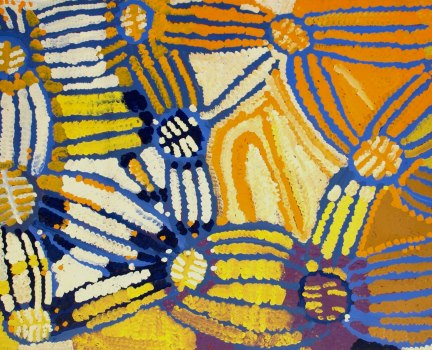
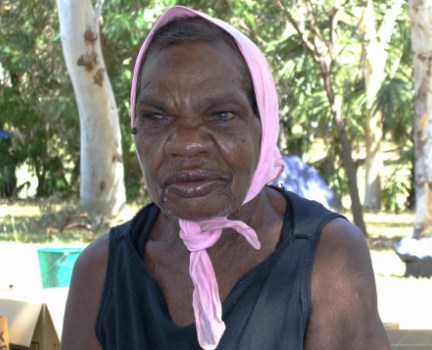
![Intel(R) JPEG Library, version [2.0.14.46]](https://japingkaaboriginalart.com/wp-content/uploads/Article-Lorna-1.jpg)
